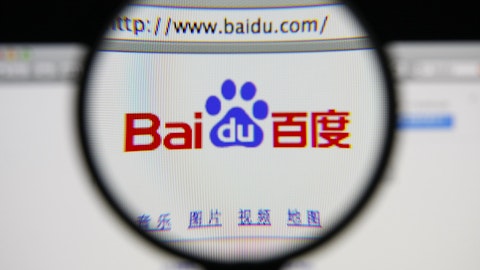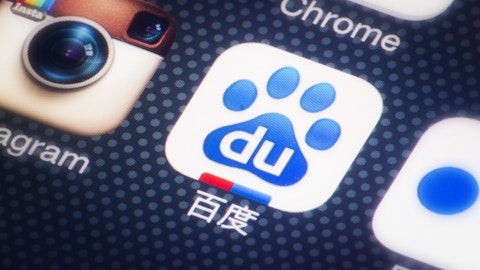Baidu, Inc. (NASDAQ:BIDU) Q3 2022 Earnings Call Transcript November 22, 2022
Baidu, Inc. beats earnings expectations. Reported EPS is $16.87, expectations were $15.33.
Operator: Thank you for standing by, and welcome to the Baidu Incorporated Third Quarter 2022 Earnings Conference Call. All participants are in a listen-only mode. There will be a presentation followed by a question-and-answer session. I would now like to hand the conference over to your host for today, Juan Lin, Baidu’s Director of Investor Relations. Please, go ahead.
Juan Lin: Hello, everyone, and welcome to Baidu’s third quarter 2022 earnings conference call. Baidu’s earnings release was distributed earlier today, and you can find a copy on our website as well as on Newswire services. On the call today, we have Robin Li, our Co-Founder and CEO; Rong Luo, our CFO; Dou Shen, our EVP in charge of Baidu AI Cloud Group; and Zhenyu Li, our SVP in charge of Baidu Intelligent Driving. After our prepared remarks, we will hold a Q&A session. Please note that the discussion today will contain forward-looking statements made under the safe harbor provisions of the US Private Securities Litigation Reform Act of 1995. Forward-looking statements are subject to risks and uncertainties that may cause actual results to differ materially from our current expectations.
For detailed discussions of these risks and uncertainties, please refer to our latest annual report and other documents filed with the SEC and Hong Kong Stock Exchange. Baidu does not undertake any obligation to update any forward-looking statements, except as required under applicable law. Our earnings press release and this call include discussions of certain unaudited non-GAAP financial measures. Our press release contains a reconciliation of the unaudited non-GAAP measures to the unaudited most directly comparable GAAP measures and is available on our IR site at ir.baidu.com. As a reminder, this conference is being recorded. In addition, a webcast of this conference call will be available on Baidu’s IR website. I will now turn over to our CEO, Robin.

Photo by Avi Richards on Unsplash
Robin Li: Hello, everyone. Recapping the third quarter in broad terms, we delivered improved bottom line results despite a challenging macro environment, especially for the mobile ecosystem, operating profit resumed positive year-over-year growth. And for AI Cloud, operating loss and margin improved meaningfully, both on a year-over-year and a quarter-over-quarter basis. Businesses across the line from mobile ecosystem to AI Cloud to Intelligent Driving have been negatively affected by the resurgence of COVID. Throughout Baidu’s history, however, we have experienced many challenging environments. Periods of challenges have enabled us to emerge stronger, given our relentless effort on building long-term growth. We’re using this period to ready ourselves for current business conditions to improve.
Our key short-term tasks remain unchanged, which are efficiency, optimization and continuous investments in the new AI businesses. Our new AI business such AI Cloud and Intelligent Driving are well aligned with China’s tech innovation and national initiatives. By doing so, we will further strengthen our leadership in the new AI business and reaccelerate business growth. In Q3, Baidu Core ad revenue was down 4% year-over-year, but improved from the second quarter’s 10% year-over-year decline, as macro has improved gradually since June. Encouragingly, revenues from healthcare and retail recorded positive year-over-year growth in the quarter. Going forward, when COVID situation alleviates in major cities ad revenues across different verticals such as travel, franchising and local services should rebound.
For our new AI business, I am proud to report some highlights. Revenues from AI Cloud increased by 24% year-on-year to RMB 4.5 billion in the quarter. AI Cloud has been a major growth driver for Baidu Core non-advertising revenue. In Q3, non-advertising accounted for 26% of Baidu Core total revenue, that’s up from 21% a year ago. Baidu Apollo auto solutions continued to gain traction among leading automakers and the total projected accumulated sales reached RMB 11.4 billion recently, growing more than 50% year-over-year. Apollo Go completed 474,000 rides in the quarter, up 311% year-over-year. By the end of Q3, Apollo Go has completed 1.4 million rides on public sales . We believe we remain the largest autonomous ride-hailing service provider globally.
Now let’s review the third quarter operational highlights. Revenues from AI Cloud increased by 24% year-over-year to RMB 4.5 billion in the quarter. In Q3, the operating loss margin for AI Cloud improved notably both year-over-year and quarter-over-quarter. Over the past quarters, we have made shifts away from some lower-margin businesses to build sustainable growth for AI Cloud. Meanwhile, we continue to take measures to standardize our solution to cut down deployment costs as we scale up. Our efforts have allowed us to gradually improve operating profit and margin. I’ll take ACE smart transportation as an example. In the past quarter, we continued to grow revenue and improve operating margin for smart transportation as we gain scale. Leveraging our strong AI capabilities and our insights into the industry, we have divested the solutions for typical use cases, such as, traffic management and V2X for urban road and highway.
Previously, we talked about how our projects help improve traffic efficiency, city roads in Beijing, Guangzhou, Changsha, Chongqing and other cities. Recently, Tuju an important transportation hub in Hunan province, adopted our smart traffic management solutions. Our solutions covered more than 70% of the major intersections in the business district of Tuju. After adopting our solutions, delays have been reduced by 22% during rush hour in the current region. By the end of the quarter, Baidu ACE Smart Transportation solutions has been adopted by 63 cities, up from 24 cities a year ago, and 51 cities a quarter ago based on contract amount of over RMB10 billion — RMB10 million per city. As we demonstrated, our capability to use AI to improve transportation efficiency in more cities, ACE Smart Transportation will further expand its market share.
We’re trying to repeat our success in smart transportation in other key verticals, such as manufacturing, energy and utilities and the public sector. We will empower our customers with AI capabilities to help them increase productivity and cost control. With AI Cloud, our customers will be better positioned to take advantage of digital intelligent transformation. We believe we remain well positioned in the early-stage, fast-growing market due to number one, our capabilities to establish end-to-end solutions based on our full stack AI capabilities ranging from chip design to deep learning frameworks, to large language models, to application-level software; and on number two, our insight about customers’ pain points and our growing know-how and capabilities to solve their profits.
While COVID caused delays in project implementation and complicated our sales team’s efforts, hampering new contract wins, we believe the long-term trend of digital and intelligent transformation remains unchanged. Looking ahead, we will continue to focus on quality growth and aim to improve margins to achieve profitability for AI Cloud. In intelligent driving, we marked several key highlights in the third quarter and our years of investing in intelligent driving and begun bearing fruit. Baidu Apollo auto solutions, our total projected accumulative sales exceeded RMB11.4 billion recently. Based on our current pipeline, some of the major car models equipped with ANP and AVP are expected to be launched in the second half of next year. We expect meaningful revenue contribution from this business to begin in 2024, and profit to expand once material revenue kicks in.
Such growth demonstrates the increasing demand for our auto solution. In Q3, we extended our partnership with one of China’s largest automotive and technology companies ANP, AVP and HD Maps for one of their popular models. As of today, we have announced a collaboration with many OEM partners. Serving various automakers has helped us standardize our auto solutions, making them compatible with more popular car model. As more cars equipped with our auto solutions get into consumer plans, we will continue to refine and update our solutions. Considering the sizable development cost for high-level autonomous driving technology, many automakers seek partnerships with reliable suppliers, who have strong brand and technology capabilities. We have differentiated ourselves with world-leading Level 4 autonomous driving, which has been established through years of investments.
Now, we are proactively building high-quality partnerships with an increasing number of auto OEMs to accelerate our partners’ progress in autonomous driving. A few months ago, we integrated Baidu Map into our intelligent driving group to create synergies between the Baidu Map, also — Baidu Map mobile app and the mass solutions for auto and transportation industries. Since our map have already been widely adopted, we have obtained more insights in the transportation industry, allowing us to strengthen our solutions for the mobility sector. On Apollo Go, we continue to scale up our operations, and we believe we remain the largest autonomous drive-hailing service provider worldwide. In the third quarter, the ride provided by Apollo Go reached 474,000, increasing 311% year-over-year and 65% quarter-over-quarter.
A vast majority of the rides were for serving passengers during rush hours, covering places like subway stations, office buildings and shopping malls. As our operation continues to expand, Apollo Go keeps learning and improving from scenarios that do not occur during the testing phase. Leveraging large-scale operations, we’re making Apollo Go, a professional AI driver, while offering a safe and comfortable autonomous ride-hailing service. Today, with an Apollo Go vehicle enters dense intersection, it is able to easily take a guess between pedestrians, bicycles and other moving objects, safety driving school while providing a comfortable experience to the passengers. Apollo Go continues to improve autonomous ride-hailing services under extreme weather.
Scalable operations have indeed reinforced our Level 4 autonomous driving capabilities, setting a strong foundation for further operation expansion. We believe this virtuous cycle will make Apollo Go, the most experienced AI driver to handle various situations on the road, on a large scale. We’re facing the expansion of Apollo Go based on a comprehensive financial model. In previous earnings calls, we talked about Apollo Go’s achievement in the Yizhuang region of Beijing. In fact, Apollo Go has achieved significant progress in other Tier 1 cities as well. In Q3, on average, each vehicle in Beijing, Shanghai and Guangzhou completed more than 15 rides per day. According to our knowledge, this number is quite close to the average daily rides for traditional ride-hailing services.
We believe that our strong and improving safety track record on public roads provide a strong endorsement for more cities to issue permits for full driverless ride-hailing. We believe fully driverless ride-hailing will create more affordable urban transport and attract more consumers to the ride-hailing market. Baidu will continue to invest to capture this massive market opportunity. Moving to the mobile ecosystem. Our operating profit improved on a year-over-year basis and we continue to generate strong cash flow in the quarter. Our mobile ecosystem continued to expand. In September, Baidu App’s MAUs increased by 5% year-over-year to 634 million. In Q3, total mobile search queries increased by double-digits year-over-year and feeds distributed through Baidu App increased by 23% year-over-year.
We continue to introduce short videos in feeds and search results. In September, short video distribution and time spend within Baidu Feed grew double-digits year-over-year. For Baidu Search, in September, 23% of the clicks on search result pages were short videos. And we expect the prevalence of video in search results to continue progressing rapidly. We’re using AI to produce more short videos for our mobile ecosystem. While it is still in a very early stage, we believe AI will allow us to generate short video much faster and more cost effectively than human-generated content. In e-commerce, users are coming to Baidu App for product search, which resulted in a continuous increase in product-related sector. Quarterly GMV facilitated by Baidu Search grow by about 52% year-over-year in Q3.
Today, users come to Baidu App not only to search for information and knowledge, but increasingly to look for services and merchandise. As we are able to make purchases and book services without leaving Baidu App, we have been deepening our understanding of user needs. Meanwhile, more customers are leveraging our ecosystem infrastructure to build their marketing campaigns and even operate their businesses on our mobile ecosystem. This has allowed us to accumulate more customer insights and better serve the customers. The improving insights into our users and customers have, in turn, allowed us to improve user experience and app conversion. In the future, we believe our mobile ecosystem will continue to generate strong profit and cash flow. To close, during this uncertain time, we focused on making the long-term investments that will position us to be stronger coming out of this challenging period, including Baidu AI Cloud and intelligent driving.
While the advertising industry has been impacted by COVID-19, some of our verticals could recover faster when there is an upturn in the economy, which will drive our ad revenue to resume growth. Before I turn the call to Rong, I want to thank Baidu’s employees for their diligent work in a challenging environment and the time and effort they put into making our company story a success in the long-term. With that, let me turn the call over to Rong to go through the financial highlights.
See also 10 Best Uranium Stocks To Buy and 11 Best TaaS Stocks To Invest In.
Rong Luo: Thank you, Robin. Now, let me walk through the details of our third quarter financial results. Total revenue was RMB32.5 billion, increasing 2% year-over-year. Revenue from Baidu Core was RMB25.2 billion, increasing 2% year-over-year. Baidu Core online marketing revenue was RMB18.7 billion, decreasing 4% year-over-year, but improved 10% from the second quarter as macro has improved gradually since June. Baidu Core, non-online marketing revenue was RMB6.5 billion, up 25% year-over-year, driven by cloud and other AI power businesses. In Q3, Baidu AI Cloud increased by 24% year-over-year to RMB4.5 billion. Revenue from ACE was RMB7.5 billion, decreasing 2% year-over-year. Cost of the revenues was RMB16.3 billion, increasing 1% year-over-year.
Baidu Core, cost of revenue was RMB10.7 billion, increasing 15%, 1-5, year-over-year, which was in line with the growth in sales of AI Cloud and other AI power businesses. Operating expenses was RMB11 billion, decreasing 19%, 1-9, year-over-year, primarily due to a decrease in channel spending, promotional marketing expenses, and staff-related expenses. Baidu Core selling, general, and administrative expenses were RMB4.2 billion, decreasing 31%, 3-1, year-over-year. SG&A accounting for 17%, 1-7, of Baidu Core revenue in the quarter and decreased from 25% in the same period last year. Baidu Core research and development expenses was RMB5.3 billion, decreasing 4% year-over-year. R&D, accounting for 21% of Baidu Core revenues in the quarter and decreased from 22% in the same period last year.
Operating income was RMB5.3 billion. Baidu Core operating income was RMB5 billion and Baidu Core operating margin was 20%. Non-GAAP operating income was RMB7.2 billion. Non-GAAP Baidu Core operating income was RMB6. 7 billion and non-GAAP Baidu Core operating margin was 26%. Q3 present the first year-over-year growth in non-GAAP operating profit and margin perspective since Q2 2021. Total other loss net was RMB4.8 billion, decreasing 78% year-over-year, which mainly including a fair value loss of RMB3.1 billion and impairment of long-term investments of RMB1.4 billion. In the third quarter last year, we recognized a fair value loss of RMB18.9 billion. A significant portion of long-term investments, including but not limited to, investments in equity securities of public and private companies, private equity funds, and digital access.
This is subject to quarterly fair value adjustments, which may contribute to net income volatility in future periods. Income tax expenses was RMB908 million compared to an income tax benefit of RMB1.8 billion in Q3 2021, primarily due to an increase in deferred tax benefit recognized on fair value loss of long-term investments and deduction of certain expenses that were previously considered non-deductible in the third quarter of 2021. Net loss attributable to Baidu was RMB146 million, and diluted loss per ADS was RMB0.87 Net income attributable to Baidu Core was RMB25 million. Non-GAAP net income attributable to Baidu was RMB5.9 billion. Non-GAAP diluted earnings per ADS was RMB16.87, non-GAAP net income attributable to Baidu Core was RMB5.8 billion, and non-GAAP net margin for Baidu Core was 23%.
Adjusted EBITDA was RMB8.9 billion and adjusted EBITDA margin was 27%. Adjusted EBITDA for Baidu Core was RMB8.2 billion and adjusted EBITDA margin for Baidu Core was 33%. As of September 30, 2022, cash, cash equivalents, restricted cash and short-term investments were RMB184.5 billion and cash, cash equivalents, restricted cash and short-term investments excluding iQIYI were RMB179.5 billion. Free cash flow was RMB6.6 billion and free cash flow excluding iQIYI was RMB6.4 billion. Baidu Core had approximately 36,500 employees as of September 30, 2022. On a separate note, ACE generate positive operating profits on both GAAP and non-GAAP basis in this quarter. The acquisition of ACE also generated positive free cash flow in this quarter. With that, operator, let’s now open the call to questions.
Q&A Session
Follow Baidu Inc (NASDAQ:BIDU)
Follow Baidu Inc (NASDAQ:BIDU)
Operator: We will now begin the question-and-answer session. The first question today comes from Alicia Yap with Citigroup. Please go ahead.
Alicia Yap: Thank you. Good evening, management. Thanks for taking my questions. I have two questions. First, can management comment how should we look at the advertising demand recovery in the near-term and it’s also in the next quarters? And then secondly, can management comment on, how you think about the competitive landscape in the China advertising market will evolve going forward? And what would Baidu long-term market share be? Thank you.
Robin Li: Hi Alicia. This is Robin. Let me answer your questions. Yes, our revenues are very sensitive to COVID control measures. Baidu Core’s ad revenues returned to positive year-over-year growth in August. But in September, it decreased again, because of new roundup COVID resurgence. Overall, Q3 was much better than Q2, because there were a recovery from the second quarter in which there were a lot of disruptions caused by COVID. When we entered the fourth quarter, the situation improved in October, but since early November, it got a bit cloudy because another round of COVID impacted some regions, like Guangzhou and Beijing. We’re closely watching how the situation will develop. I think the short-term will probably still be quite volatile, but the economy should improve in the mid-term and beyond.
China has been fighting against this COVID for almost three years and the country has been gaining experience. Well, we’re certainly going to see some ongoing disruptions and uncertainties. The overall situation should improve — should move in a positive direction over the next few quarters. As you know, many of our ad verticals were affected by COVID and macro. So once COVID and macro situations improve, our ad revenues from different verticals such as travel, franchising or local services should rebound. Again, we will closely watch how COVID situation develops, and we will work very hard to bring our ad revenue back to a positive year-over-year growth as soon as possible. In addition, AI Cloud and intelligent driving, our new business also negatively impacted by the COVID disruption.
So if COVID impact the supplies, these non-advertising businesses should also see improvement. And regarding to your question on competition in the online advertising market, first of all, I think Baidu App is one of the very few super apps in China’s mobile internet industry, well-recognized and well-established. Search ads enjoying the best ROI among various types of performance ad because users explicitly express their intent in our search box. And search ads connect users’ intentions with the most relevant product and service offerings. This is why a lot of advertisers consider Baidu Search as the most important and most efficient channel to reach their targeted audience. And secondly, China’s mobile internet is maturing. User growth is gradually slowing down and the competitive landscape is much less volatile than before.
With this backdrop, Baidu App still managed to grow its user base nicely over the past many quarters. On top of that, with the unique positioning of search, we believe we should be able to sustain our market share in the online advertising market over the long run. And thirdly, unlike our peers, most of our advertisers are SMEs, being in the real economy. Many of them run businesses in the service sector such as local services, business services and travel. This business is work hurt the most by the pandemic. So when COVID impact subside, and revenue should rebound quickly. And Baidu stand to gain share in the overall advertising industry.





